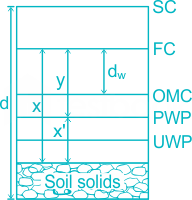Methods of Soil Exploration
- 1. Direct methods: Test pits, trial pits or trenches.
- 2. Semi-direct methods: Borings
- 3. Indirect methods: Soundings or penetration tests and geophysical methods
Test Pits
- This test is suitable only for small depths up to 3 m.
- For excavation of pervious soils at great depths, lateral supports or bracings are required.
- Useful for conducting field tests, such as plate bearing test.
- Test pits are usually made only for supplementing other
- methods or for minor structures.
Boring
- Boring is a method of making or drilling bore holes into the ground for obtaining soil or rock samples from known or specified depths.
- Depending upon the type of soil and the purpose of boring, the following methods are used for drilling the holes.
1. Auger boring:
- This method is effective for subsurface investigations of highways, railways and airfields, where the depth of exploration is small.
- This method is, generally, used in soils which can stay open without casing or drilling mud, such as clays, silts, etc.
The main disadvantage of auger boring is that the soil samples are highly disturbed.
2. Wash boring:
- Used for exploration below ground water table for which the Auger method is not suitable.
- This method cannot be efficiently applied in hard soils, rocks and soils containing boulders.
- The hole is advanced by a combination of chop-ping action and jetting action.
3. Rotary drilling:
- It is used in clay sands and rocks. This method is not suitable if material contains large percentage of particles of gravel
- The hole is advanced by rotating a hollow drill rod which has a cutting bit at its lower end.
4. Percussion drilling:
- This method is suitable for making holes in rocks, boulders and other hard strata.
- It is useful for drilling holes in glacial tills containing boulders.
- In this method, a heavy chisel is alternately lifted and dropped in a vertical hole.
5. Core drilling:
- • This method is used for drilling holes and obtaining rock cores.
- • Diamond-cutting edge is used.
Spacing of Borings
- The spacing of borings or the number of borings depends on the type, size and weight of the proposed structure, variation in soil conditions.
- For an area of about 0.4 hectare, one bore hole or trial pit in each corner and one is the centre should be adequate.
- For smaller and less important buildings, one bore hole at the cente is sufficient.
Depth of Borings
Soil Sampling
- It is the process of obtaining soil samples from the desired depth at the desired location in a natural soil deposit to assess the engineering properties of soil.
- The devices used for the purpose of sampling are known as soil samplers.

















.jpg/220px-Spijkers_(Nails).jpg)








